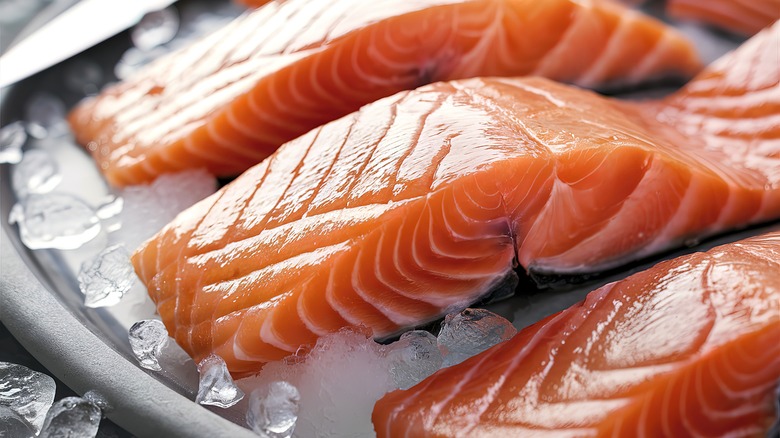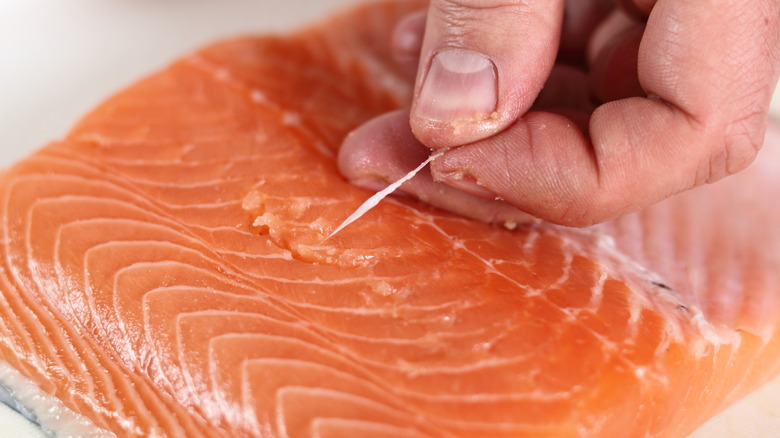The Timesaving Tip To Remember When Buying A Cut Of Salmon
When it comes time to plan your proteins for the week, salmon is a brilliant option. Not only is it delicious and versatile, but it comes with a slew of valuable vitamins and nutrients — including the oft-talked-about, heart-healthy omega-3 fatty acids. Regularly adding salmon to your dinner plans can seem like a hassle, though, because let's be honest: No one wants to deal with those pesky little pin bones.
That can add some major meal prep to your day, and who has time for that? If that's made you give up on salmon in the past, we have good news for anyone who loves the many simple, spectacular ways there are to prepare salmon. That's the fact that when you buy fresh salmon at your favorite grocery store or fishmonger, you can ask them to remove those pin bones for you.
Many places will be happy to do so — it's all a part of good customer service, after all. There are times when they might decline: They might be short-staffed, or it might be a busy time of day, and it's a time-consuming process even for professionals. But nothing ventured, nothing gained, so don't be afraid to ask. Also, keep in mind that you must consider those pin bones when you're prepping salmon.
Here's why you should be careful of pin bones
The fact that they're called "pin bones" is a little misleading, as they're not actually bones. These inconvenient little things are incredibly thin, sharp, calcified nerve endings, and yes, they are edible. In fact, they're high in iron and calcium. However, that comes with a massive caveat: They can still present a major choking hazard.
Pin bones can get lodged in your throat, and certain people are at a higher risk of having this happen. Children and anyone who has dentures are considered at high risk for developing complications related to fish bones, so keep all that in mind when you're wondering exactly how careful you need to be when you're looking at salmon.
The good news is that pin bones can easily be removed from salmon filets, and although it might take a while, you're not asking the employees at the fish counter to do anything outside their area of expertise. Pin bones are easy to find — they're in a straight line along the filet — and since they're not attached to other bones, it's just a matter of pulling them out. Still, since it might take a while, consider making the fish counter your first stop and asking for it to be prepared for you while you do the rest of your shopping.
You should try to buy fresh, bone-in salmon anyway, and here's why
It might be tempting to get some de-boned, frozen salmon and be done with it. But you should consider finding a trustworthy place for fresh fish if you add it to your meal plan regularly. Why? Buying fresh fish is, of course, the best way to make sure that it's, well ... fresh. There are some red flags to look out for when buying fresh seafood, but seeing the whole fish, or at least large filets, is a great way to reassure yourself that it hasn't been sitting around longer than it should have been.
There's something specific at work here with salmon, too: When salmon is de-boned at a processing plant, they rely on machinery to make this time-intensive task more efficient. Since machines struggle with firmer fish, it's often left to soften for a few days before it's de-boned. Suddenly, that conveniently de-boned fish doesn't sound so fresh, does it?
Fortunately, you can get the best of both worlds if you ask for a filet of fresh salmon to be de-boned before you check out at the store. Look for a fish that's pink (and free of dark blemishes), smells like the ocean, and the flesh should be firm, not soft. You'll never skip salmon again.


